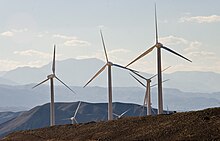|
Wind power in Iran
 The energy system of Iran relies primarily on fossil fuels. However, the country has made steps to decrease its dependency on fossil fuels by investing in wind power.[1] In 2004 Iran generated only 25 megawatts from wind power, 32 megawatts in 2005, and 45 megawatts in 2006. By 2009, total wind power capacity reached 130 megawatts. This was a result of the production of larger wind farms in more coastal and windy areas of Iran, such as Manjeel (Gilan province) and Binaloud (Razavi Khorasan Province).[2][3] In 2021, Iran's total capacity of onshore wind power grew by 0.6%.[4] By 2021, the total amount of produced energy from wind farms was 310 MW in Iran.[5] In March 2023, 'Mil Nader' 50-MW wind farm became operation in Sistan and Baluchestan province.[6] HistoryEnergy infrastructure of Iran was mainly based on fossil fuels. However, by investing in wind electricity, the country has taken measures to reduce its reliance on fossil fuels. With the help from Sadid Industrial Group (Iranian manufacturing company) and investments as well as resources from Indian (Sulzon Energy) and German (Siemens) wind turbine companies, Iran has been able to build a strong and stable wind sector.[1] To boost up the wind energy production, the Renewable Energy Organization of Iran (SUNA) based its new feed-in tariff policy on the German equivalent, assured government electricity sales for 20 years, and implemented a 15% tax cut for businesses using domestic components.[7] According to the Iranian minister of powder, before the revolution, foreign states provided the infrastructure for the electricity sector in Iran, and Iranian technicians were only permitted to replace the transformer oil. Today, however, the Iranian electricity sector has almost entirely attained self-sufficiency.[6] Largest wind farms
See also
References
Bibliography
External linksWikimedia Commons has media related to Wind power in Iran.
|
